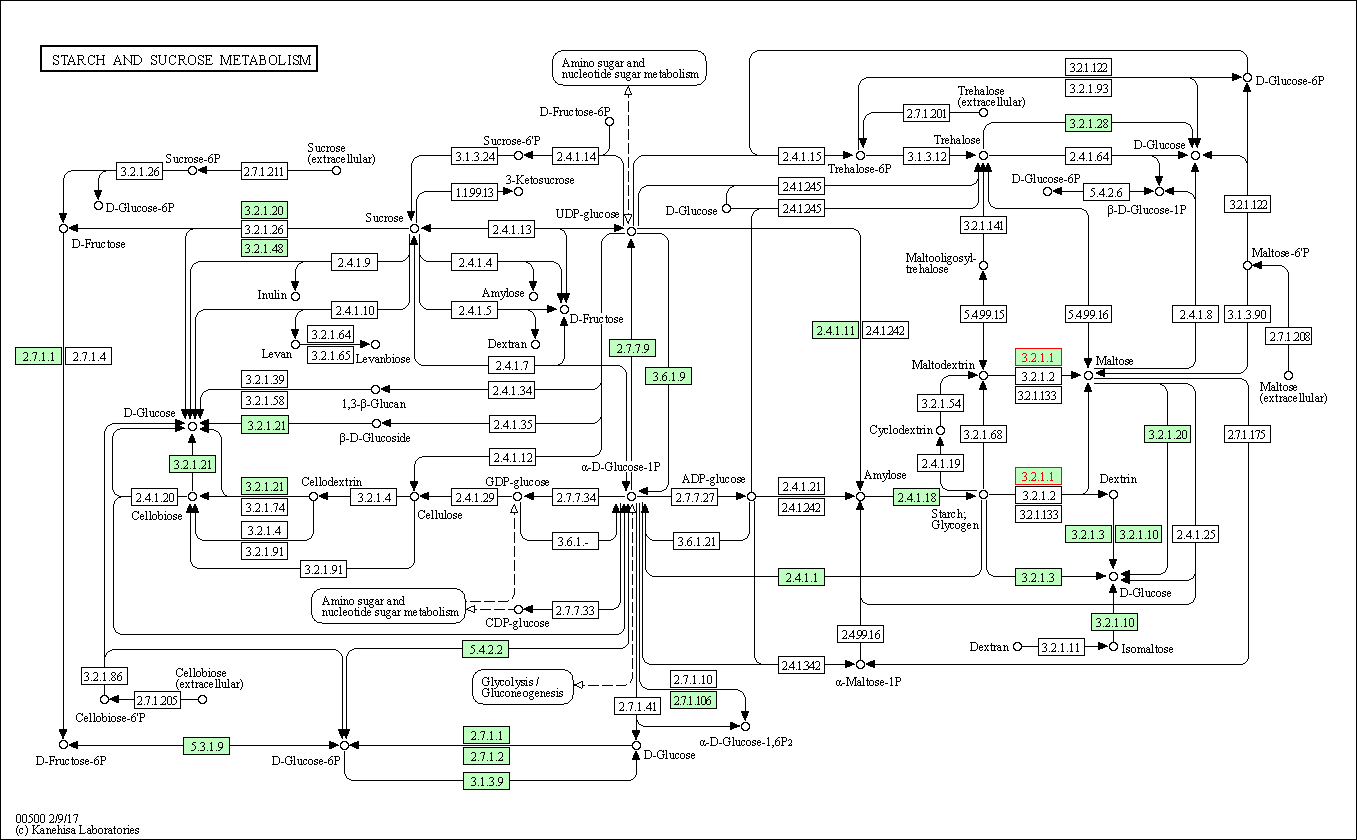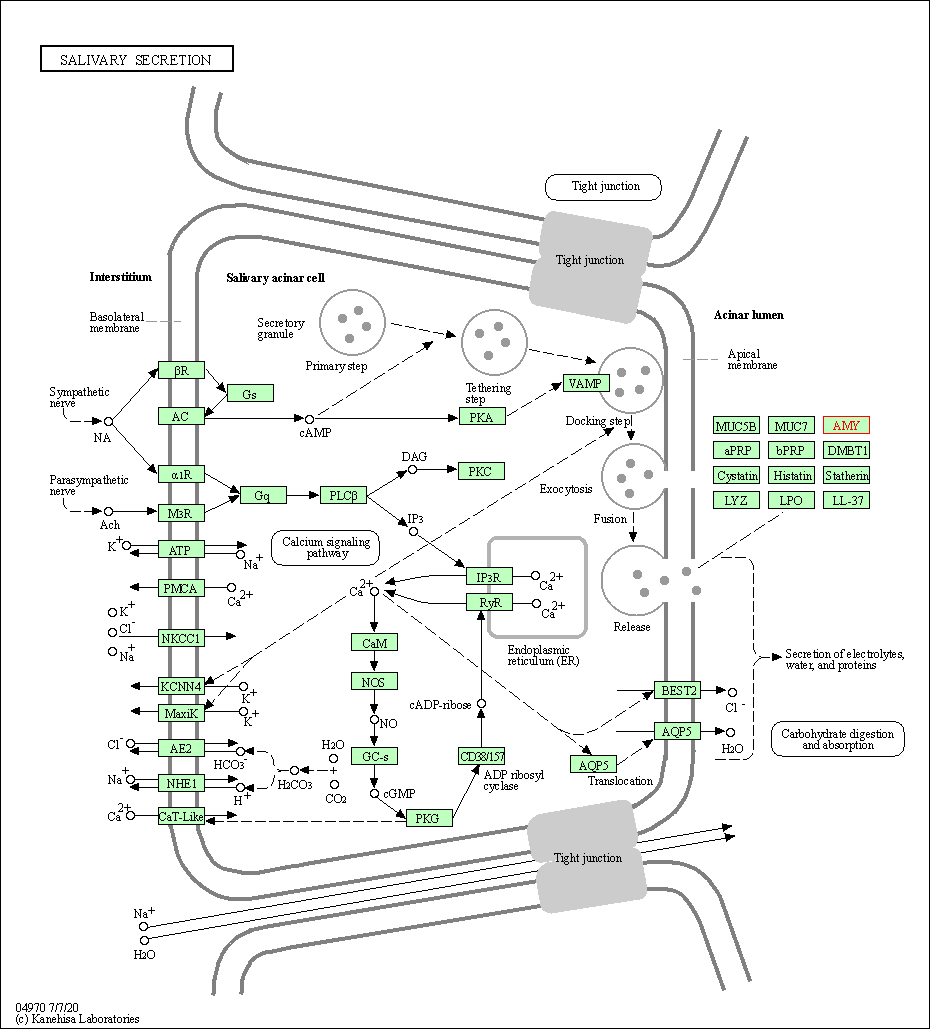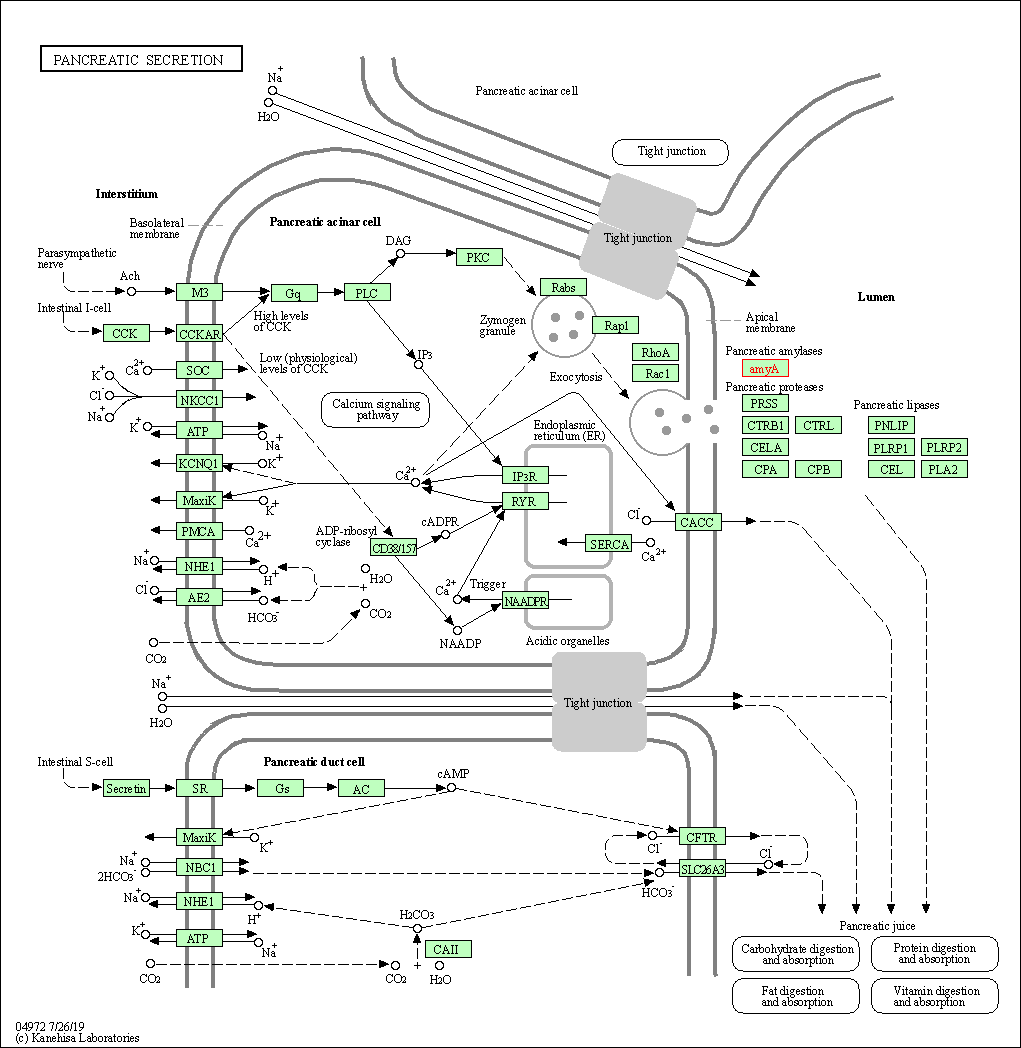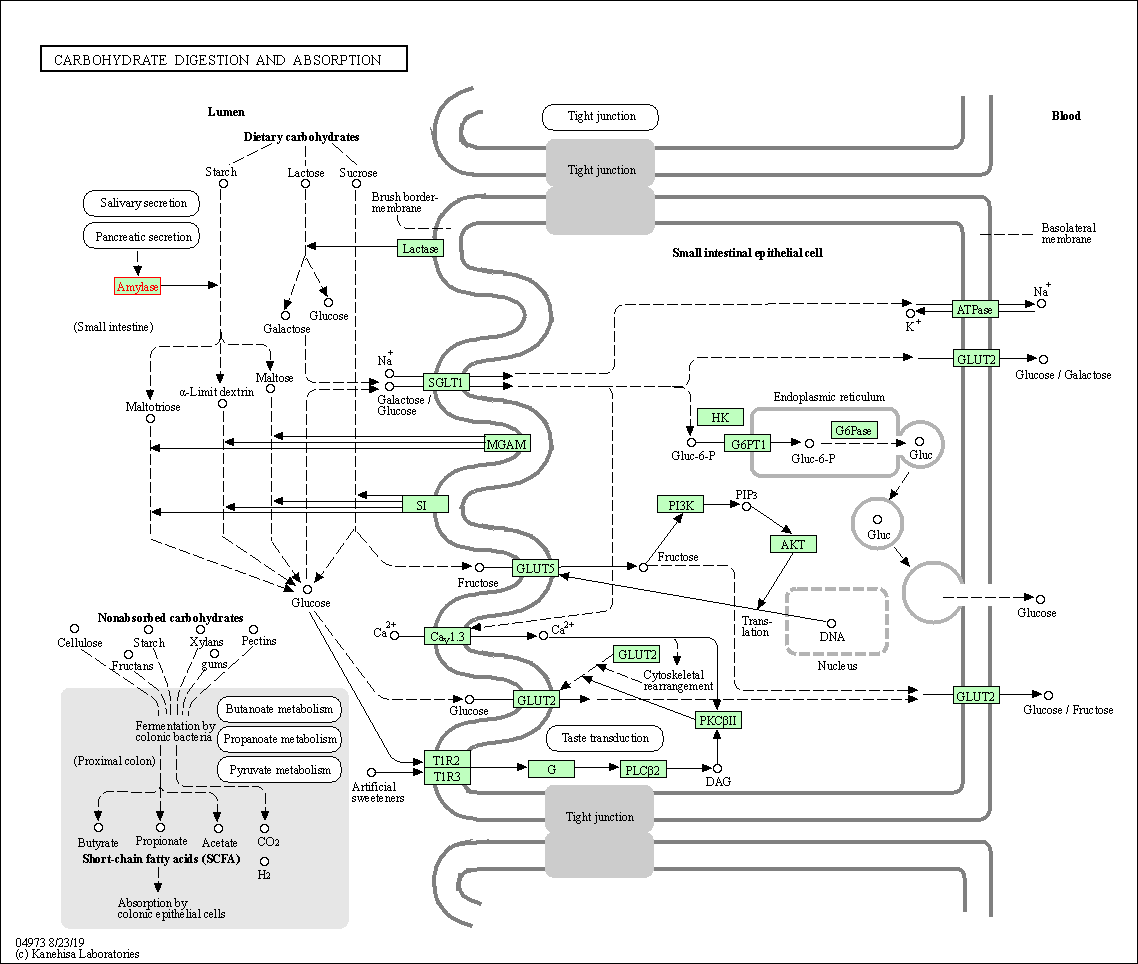Target Information
| Target General Information | Top | |||||
|---|---|---|---|---|---|---|
| Target ID |
T86918
(Former ID: TTDS00397)
|
|||||
| Target Name |
Pancreatic alpha-amylase (AMY2A)
|
|||||
| Synonyms |
PA; 1,4-alpha-D-glucan glucanohydrolase
Click to Show/Hide
|
|||||
| Gene Name |
AMY2A
|
|||||
| Target Type |
Clinical trial target
|
[1] | ||||
| Disease | [+] 2 Target-related Diseases | + | ||||
| 1 | Pancreatic malfunction [ICD-11: DC30-DC3Z] | |||||
| 2 | Cystic fibrosis [ICD-11: CA25] | |||||
| Function |
Hydrolyses alpha bonds of large, alpha-linked polysaccharides, such as starch and glycogen, yielding glucose and maltose.
Click to Show/Hide
|
|||||
| BioChemical Class |
Glycosylase
|
|||||
| UniProt ID | ||||||
| EC Number |
EC 3.2.1.1
|
|||||
| Sequence |
MKFFLLLFTIGFCWAQYSPNTQQGRTSIVHLFEWRWVDIALECERYLAPKGFGGVQVSPP
NENVAIYNPFRPWWERYQPVSYKLCTRSGNEDEFRNMVTRCNNVGVRIYVDAVINHMCGN AVSAGTSSTCGSYFNPGSRDFPAVPYSGWDFNDGKCKTGSGDIENYNDATQVRDCRLTGL LDLALEKDYVRSKIAEYMNHLIDIGVAGFRLDASKHMWPGDIKAILDKLHNLNSNWFPAG SKPFIYQEVIDLGGEPIKSSDYFGNGRVTEFKYGAKLGTVIRKWNGEKMSYLKNWGEGWG FVPSDRALVFVDNHDNQRGHGAGGASILTFWDARLYKMAVGFMLAHPYGFTRVMSSYRWP RQFQNGNDVNDWVGPPNNNGVIKEVTINPDTTCGNDWVCEHRWRQIRNMVIFRNVVDGQP FTNWYDNGSNQVAFGRGNRGFIVFNNDDWSFSLTLQTGLPAGTYCDVISGDKINGNCTGI KIYVSDDGKAHFSISNSAEDPFIAIHAESKL Click to Show/Hide
|
|||||
| 3D Structure | Click to Show 3D Structure of This Target | PDB | ||||
| HIT2.0 ID | T36KIV | |||||
| Drugs and Modes of Action | Top | |||||
|---|---|---|---|---|---|---|
| Clinical Trial Drug(s) | [+] 2 Clinical Trial Drugs | + | ||||
| 1 | Pancrecarb | Drug Info | NDA filed | Pancreatic malfunction | [1] | |
| 2 | Liprotamase | Drug Info | Phase 3 | Cystic fibrosis | [2] | |
| Mode of Action | [+] 2 Modes of Action | + | ||||
| Modulator | [+] 2 Modulator drugs | + | ||||
| 1 | Pancrecarb | Drug Info | [1] | |||
| 2 | Liprotamase | Drug Info | [3] | |||
| Inhibitor | [+] 9 Inhibitor drugs | + | ||||
| 1 | 5-Hydroxymethyl-Chonduritol | Drug Info | [4] | |||
| 2 | 6-Deoxy-Alpha-D-Glucose | Drug Info | [4] | |||
| 3 | Acanthus ilicifolius Linn | Drug Info | [5] | |||
| 4 | Acarbose Derived Hexasaccharide | Drug Info | [4] | |||
| 5 | Alpha-acarviosinyl-(1-->7)-3-alpha-D-glucopyranosylpropen | Drug Info | [6] | |||
| 6 | Alpha-acarviosinyl-(1-->9)-3-alpha-D-glucopyranosylpropen | Drug Info | [6] | |||
| 7 | Beta-D-Glucose | Drug Info | [4] | |||
| 8 | Hydroxycitric acid | Drug Info | [7] | |||
| 9 | Maltosyl-Alpha (1,4)-D-Gluconhydroximo-1,5-Lactam | Drug Info | [8] | |||
| Cell-based Target Expression Variations | Top | |||||
|---|---|---|---|---|---|---|
| Cell-based Target Expression Variations | ||||||
| Drug Binding Sites of Target | Top | |||||
|---|---|---|---|---|---|---|
| Ligand Name: Pyroglutamic Acid | Ligand Info | |||||
| Structure Description | Montbretin A analogue M06-MbA in complex with Human pancreatic alpha-amylase | PDB:6OCN | ||||
| Method | X-ray diffraction | Resolution | 1.15 Å | Mutation | Yes | [9] |
| PDB Sequence |
YSPNTQQGRT
11 SIVHLFEWRW21 VDIALECERY31 LAPKGFGGVQ41 VSPPNENVAI51 YNPFRPWWER 61 YQPVSYKLCT71 RSGNEDEFRN81 MVTRCNNVGV91 RIYVDAVINH101 MCGNAVSAGT 111 SSTCGSYFNP121 GSRDFPAVPY131 SGWDFNDGKC141 KTGSGDIENY151 NDATQVRDCR 161 LTGLLDLALE171 KDYVRSKIAE181 YMNHLIDIGV191 AGFRLDASKH201 MWPGDIKAIL 211 DKLHNLNSNW221 FPAGSKPFIY231 QEVIDLGGEP241 IKSSDYFGNG251 RVTEFKYGAK 261 LGTVIRKWNG271 EKMSYLKNWG281 EGWGFVPSDR291 ALVFVDNHDN301 QRGHGAGGAS 311 ILTFWDARLY321 KMAVGFMLAH331 PYGFTRVMSS341 YRWPRQFQNG351 NDVNDWVGPP 361 NNNGVIKEVT371 INPDTTCGND381 WVCEHRWRQI391 RNMVIFRNVV401 DGQPFTNWYD 411 NGSNQVAFGR421 GNRGFIVFNN431 DDWSFSLTLQ441 TGLPAGTYCD451 VISGDKINGN 461 CTGIKIYVSD471 DGKAHFSISN481 SAEDPFIAIH491 AESKL
|
|||||
|
|
||||||
| Click to View More Binding Site Information of This Target and Ligand Pair | ||||||
| Ligand Name: Myricetin | Ligand Info | |||||
| Structure Description | Human Pancreatic alpha-amylase in complex with myricetin | PDB:4GQR | ||||
| Method | X-ray diffraction | Resolution | 1.20 Å | Mutation | No | [10] |
| PDB Sequence |
YSPNTQQGRT
11 SIVHLFEWRW21 VDIALECERY31 LAPKGFGGVQ41 VSPPNENVAI51 YNPFRPWWER 61 YQPVSYKLCT71 RSGNEDEFRN81 MVTRCNNVGV91 RIYVDAVINH101 MCGNAVSAGT 111 SSTCGSYFNP121 GSRDFPAVPY131 SGWDFNDGKC141 KTGSGDIENY151 NDATQVRDCR 161 LTGLLDLALE171 KDYVRSKIAE181 YMNHLIDIGV191 AGFRLDASKH201 MWPGDIKAIL 211 DKLHNLNSNW221 FPAGSKPFIY231 QEVIDLGGEP241 IKSSDYFGNG251 RVTEFKYGAK 261 LGTVIRKWNG271 EKMSYLKNWG281 EGWGFVPSDR291 ALVFVDNHDN301 QRGHGAGGAS 311 ILTFWDARLY321 KMAVGFMLAH331 PYGFTRVMSS341 YRWPRQFQNG351 NDVNDWVGPP 361 NNNGVIKEVT371 INPDTTCGND381 WVCEHRWRQI391 RNMVIFRNVV401 DGQPFTNWYD 411 NGSNQVAFGR421 GNRGFIVFNN431 DDWSFSLTLQ441 TGLPAGTYCD451 VISGDKINGN 461 CTGIKIYVSD471 DGKAHFSISN481 SAEDPFIAIH491 AESKL
|
|||||
|
|
||||||
| Click to View More Binding Site Information of This Target with Different Ligands | ||||||
| Different Human System Profiles of Target | Top |
|---|---|
|
Human Similarity Proteins
of target is determined by comparing the sequence similarity of all human proteins with the target based on BLAST. The similarity proteins for a target are defined as the proteins with E-value < 0.005 and outside the protein families of the target.
A target that has fewer human similarity proteins outside its family is commonly regarded to possess a greater capacity to avoid undesired interactions and thus increase the possibility of finding successful drugs
(Brief Bioinform, 21: 649-662, 2020).
Human Tissue Distribution
of target is determined from a proteomics study that quantified more than 12,000 genes across 32 normal human tissues. Tissue Specificity (TS) score was used to define the enrichment of target across tissues.
The distribution of targets among different tissues or organs need to be taken into consideration when assessing the target druggability, as it is generally accepted that the wider the target distribution, the greater the concern over potential adverse effects
(Nat Rev Drug Discov, 20: 64-81, 2021).
Human Pathway Affiliation
of target is determined by the life-essential pathways provided on KEGG database. The target-affiliated pathways were defined based on the following two criteria (a) the pathways of the studied target should be life-essential for both healthy individuals and patients, and (b) the studied target should occupy an upstream position in the pathways and therefore had the ability to regulate biological function.
Targets involved in a fewer pathways have greater likelihood to be successfully developed, while those associated with more human pathways increase the chance of undesirable interferences with other human processes
(Pharmacol Rev, 58: 259-279, 2006).
Biological Network Descriptors
of target is determined based on a human protein-protein interactions (PPI) network consisting of 9,309 proteins and 52,713 PPIs, which were with a high confidence score of ≥ 0.95 collected from STRING database.
The network properties of targets based on protein-protein interactions (PPIs) have been widely adopted for the assessment of target’s druggability. Proteins with high node degree tend to have a high impact on network function through multiple interactions, while proteins with high betweenness centrality are regarded to be central for communication in interaction networks and regulate the flow of signaling information
(Front Pharmacol, 9, 1245, 2018;
Curr Opin Struct Biol. 44:134-142, 2017).
Human Similarity Proteins
Human Tissue Distribution
Human Pathway Affiliation
Biological Network Descriptors
|
|
|
There is no similarity protein (E value < 0.005) for this target
|
|
Note:
If a protein has TS (tissue specficity) scores at least in one tissue >= 2.5, this protein is called tissue-enriched (including tissue-enriched-but-not-specific and tissue-specific). In the plots, the vertical lines are at thresholds 2.5 and 4.
|
| KEGG Pathway | Pathway ID | Affiliated Target | Pathway Map |
|---|---|---|---|
| Starch and sucrose metabolism | hsa00500 | Affiliated Target |

|
| Class: Metabolism => Carbohydrate metabolism | Pathway Hierarchy | ||
| Salivary secretion | hsa04970 | Affiliated Target |

|
| Class: Organismal Systems => Digestive system | Pathway Hierarchy | ||
| Pancreatic secretion | hsa04972 | Affiliated Target |

|
| Class: Organismal Systems => Digestive system | Pathway Hierarchy | ||
| Carbohydrate digestion and absorption | hsa04973 | Affiliated Target |

|
| Class: Organismal Systems => Digestive system | Pathway Hierarchy | ||
| Degree | 3 | Degree centrality | 3.22E-04 | Betweenness centrality | 1.34E-04 |
|---|---|---|---|---|---|
| Closeness centrality | 1.31E-01 | Radiality | 1.11E+01 | Clustering coefficient | 0.00E+00 |
| Neighborhood connectivity | 3.00E+00 | Topological coefficient | 6.67E-01 | Eccentricity | 14 |
| Download | Click to Download the Full PPI Network of This Target | ||||
| Chemical Structure based Activity Landscape of Target | Top |
|---|---|
| Drug Property Profile of Target | Top | |
|---|---|---|
| (1) Molecular Weight (mw) based Drug Clustering | (2) Octanol/Water Partition Coefficient (xlogp) based Drug Clustering | |
|
|
||
| (3) Hydrogen Bond Donor Count (hbonddonor) based Drug Clustering | (4) Hydrogen Bond Acceptor Count (hbondacc) based Drug Clustering | |
|
|
||
| (5) Rotatable Bond Count (rotbonds) based Drug Clustering | (6) Topological Polar Surface Area (polararea) based Drug Clustering | |
|
|
||
| "RO5" indicates the cutoff set by lipinski's rule of five; "D123AB" colored in GREEN denotes the no violation of any cutoff in lipinski's rule of five; "D123AB" colored in PURPLE refers to the violation of only one cutoff in lipinski's rule of five; "D123AB" colored in BLACK represents the violation of more than one cutoffs in lipinski's rule of five | ||
| Target Poor or Non Binders | Top | |||||
|---|---|---|---|---|---|---|
| Target Poor or Non Binders | ||||||
| References | Top | |||||
|---|---|---|---|---|---|---|
| REF 1 | Clinical pipeline report, company report or official report of Digestive Care. | |||||
| REF 2 | ClinicalTrials.gov (NCT00500084) Phase III ALTU-135 CP Safety Trial. U.S. National Institutes of Health. | |||||
| REF 3 | Clinical pipeline report, company report or official report of Anthera Pharmaceuticals. | |||||
| REF 4 | How many drug targets are there Nat Rev Drug Discov. 2006 Dec;5(12):993-6. | |||||
| REF 5 | Four acarviosin-containing oligosaccharides identified from Streptomyces coelicoflavus ZG0656 are potent inhibitors of alpha-amylase. Carbohydr Res. 2008 Apr 7;343(5):882-92. | |||||
| REF 6 | Enzymatic synthesis of a selective inhibitor for alpha-glucosidases: alpha-acarviosinyl-(1-->9)-3-alpha-D-glucopyranosylpropen. J Agric Food Chem. 2008 Jul 9;56(13):5324-30. | |||||
| REF 7 | Chemistry, physiological properties, and microbial production of hydroxycitric acid. Appl Microbiol Biotechnol. 2007 Jul;75(5):977-82. | |||||
| REF 8 | DrugBank 3.0: a comprehensive resource for 'omics' research on drugs. Nucleic Acids Res. 2011 Jan;39(Database issue):D1035-41. | |||||
| REF 9 | Synthesis of montbretin A analogues yields potent competitive inhibitors of human pancreatic Alpha-amylase. Chem Sci. 2019 Oct 18;10(48):11073-11077. | |||||
| REF 10 | Order and disorder: differential structural impacts of myricetin and ethyl caffeate on human amylase, an antidiabetic target. J Med Chem. 2012 Nov 26;55(22):10177-86. | |||||
If You Find Any Error in Data or Bug in Web Service, Please Kindly Report It to Dr. Zhou and Dr. Zhang.

